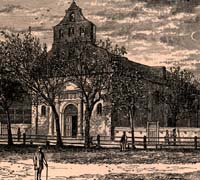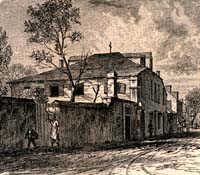The Calvin Shedd Papers > Background > St. Augustine, Florida
St. Augustine, Florida
| Date(s) of Letter(s) | Fretwell,
Jacqueline, Ed. Civil War Times in St. Augustine. St. Augustine, Florida: St.
Augustine Historical Society, 1986. Little, Henry F. W. The Seventh Regiment New Hampshire Volunteers in the War of the Rebellion. Concord, New Hampshire: Seventh New Hampshire Veteran Association, 1896. |
| September 29, 1862 October 12, 1862 October 19, 1862 |
"For fourteen
months following the secession St. Augustine was a part of the confederacy, but for the
remaining three years of the Civil War the town was occupied by the military forces of the
United States....On February 28 [1862], a fleet of 26 U.S. Navy ships set sail from
Department of the South headquarters at Hilton Head, South Carolina, to occupy Fernandina,
Jacksonville, and St. Augustine." The Federal troops were able to take St.
Augustine without a fight, as the rebel troops surrendered. The American flag was
raised at Fort Marion by town leaders. They wanted to restore St. Augustine to its
state of affairs before the war. Many of the citizens were staunch rebel
sympathizers, though, and the Federals realized they may have underestimated the military
threat the Confederates would be able to mount against the invasion. The Federals
added more troops to the city and made improvements to the town's defenses."
(Fretwell, pp. 19, 68-70) "Upon our arrival at this place, a portion of the regiment was ordered at and near old Fort Marion, at the northern extremity of the city, and the remaining companies were ordered into the spacious barracks near the southern limits, belonging to the government, but which had been years before an old Franciscan convent. Here we found good quarters, good food, and the duties not severe, and we had not been here long before a great change in the health of the regiment was noticed." "As soon as we had become fairly settled down in our new quarters, we began to inspect the town, and note the inhabitants, many of them who were originally Minorcans, from the island of Minorca, Italy;y, and the others seemed to be mixed largely with Spanish or French blood. The streets we found to be very narrow, and the buildings were constructed very much like a prison on the lower floor, while the second floor would invariably have a balcony projecting out over the street....In the center of the city we found a pretty square, with the remains of a neat fence yet partially around it...and surrounding it on the north side was the old stone cathedral with its quaint old chime of bells, which were wont to toll the curfew as evening shades appeared....At the south end of the city, down below the barracks, was a nice large plateau which we used as a drill ground, and a splendid place it made, as it was almost level and well grassed over." "It was at this post that we came in contact with plenty of sweet oranges, limes, and pomegranates, and we had sweet potatoes in plenty, and the best of fresh fish, oysters, and quahaug clams in abundance....Many of the families got onto the business of making corn pone and sweet potato pone, and it always found a ready sale, as our sutler's checks passed the same as silver and gold among the inhabitants; but after a time some of the vendors began to grind up hard-tack which they drew as rations from our commissary department, as we supposed to keep them from starving, and mixing it with the potato, sold us a very inferior article, and from that time the pone business was almost entirely killed." (Little, pp. 66-75) |


|
|
